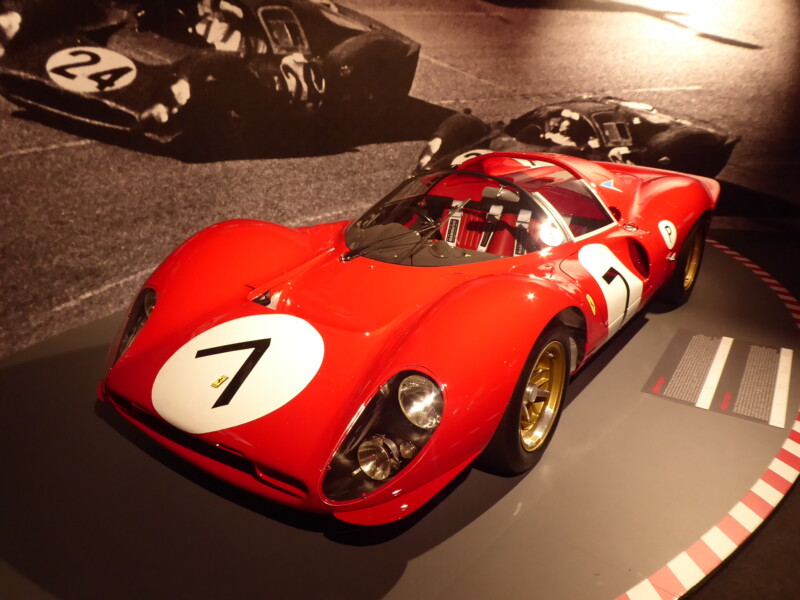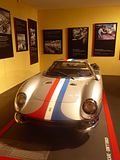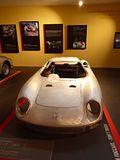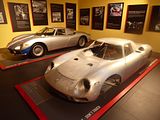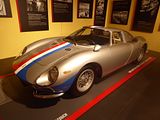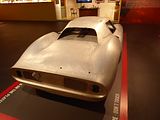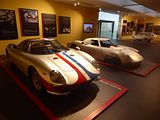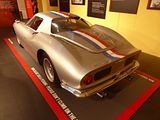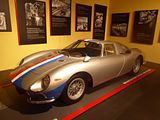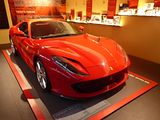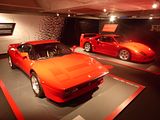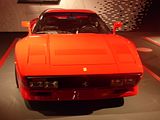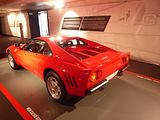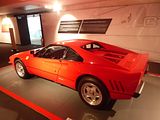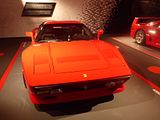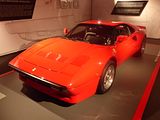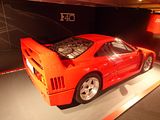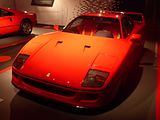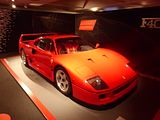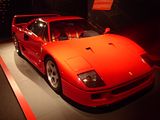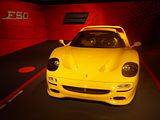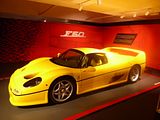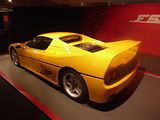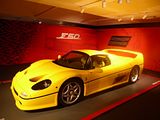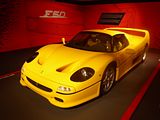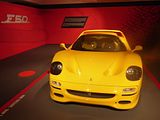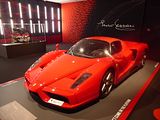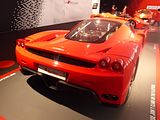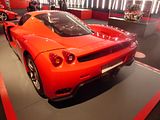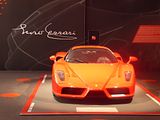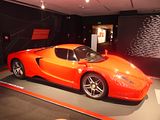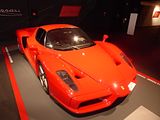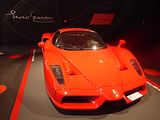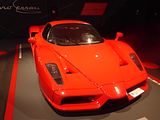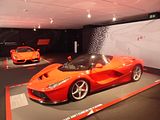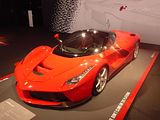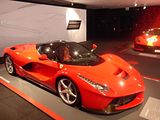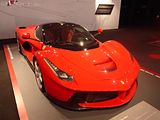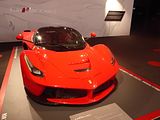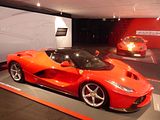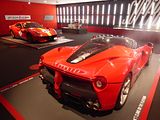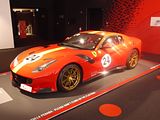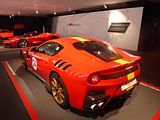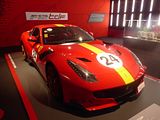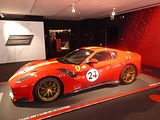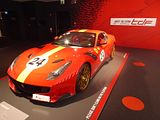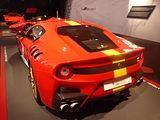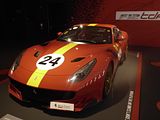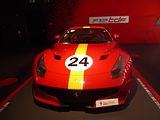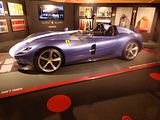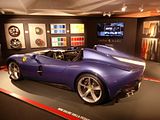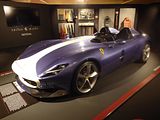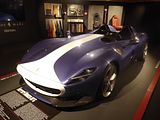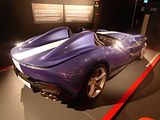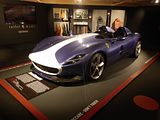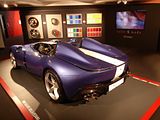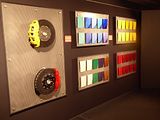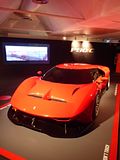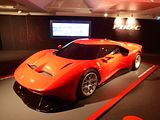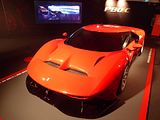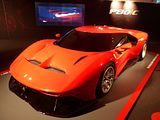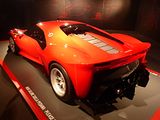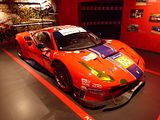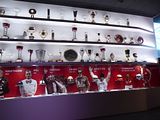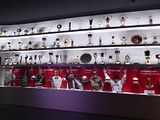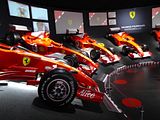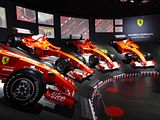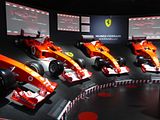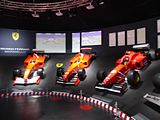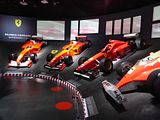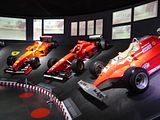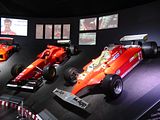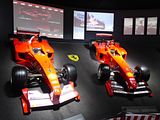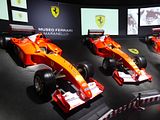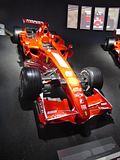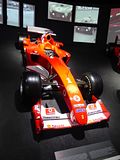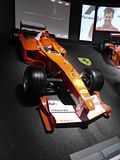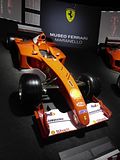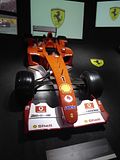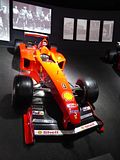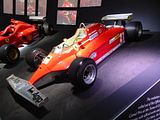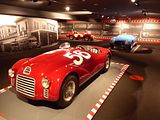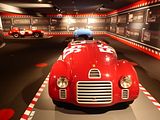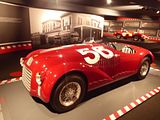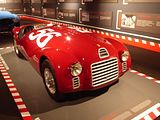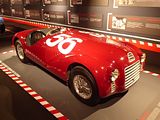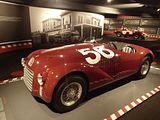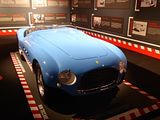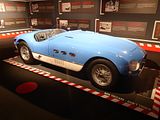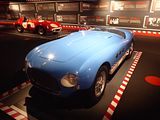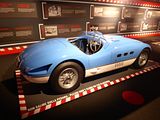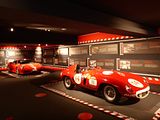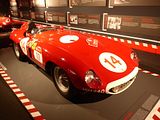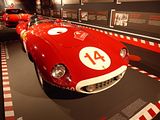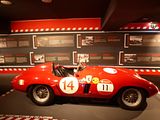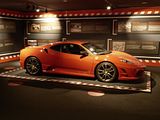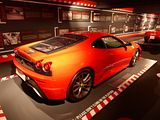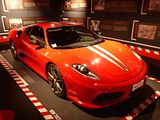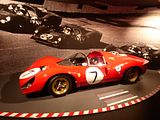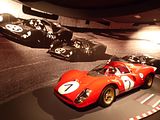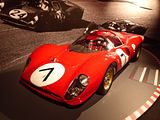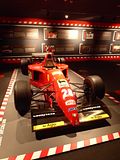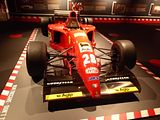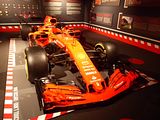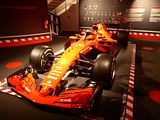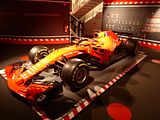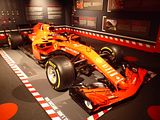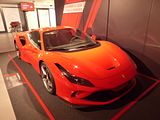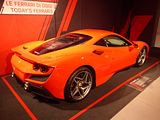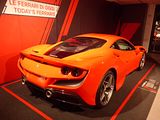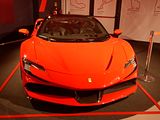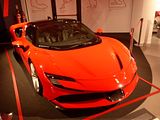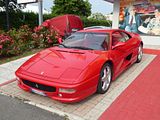For the past ten years there have been two Ferrari museums in Italy for the fans and enthusiasts to enjoy. The larger and longer established of the pair is to be found in Maranello, the proverbial stone’s throw away from the factory complex and the Fiorano test track. Needless to say, it attracts a vast number of visitors who come to what would otherwise be a small Italian town some 12 km south of Modena that, whilst attractive enough, would probably not feature on many travel itineraries. Over the years the museum has been developed, expanded and remodelled a number of times and these days it is kept fresh by fairly frequent changes of the displays. In the 74 years of the Ferrari company there is a rich heritage of both road and race cars and so it is only ever possible to include a relatively small set of the treasures of this much loved marque in displays. Both museums adopt a policy of adopting one or more themes for the displays at any one time, meaning that you if you keep going back to the museums,,as I do, you are likely to see a subset of some of the same cars from the factory collection but in different combinations, and there are also cars loaned in private owners and collectors to complete special exhibitions. As Maranello and Modena are only 12 km, or about 30 minutes, apart, it is perfectly feasible to visit both museums in the same day and still have time to do other touristic things, and that is exactly what I did during my June 2022 trip to the area. Unlike the Casa Enzo Ferrari in Modena where the entire display changes on an annual basis, at the Galleria Ferrari I found that some of the displays were different and some the same as on my last visit to the museum in September 2020. Here is what I saw:
THE MAKING OF A FERRARI
First of the displays showed some of what goes into the construction of the body of a Ferrari, with a couple of pairs of cars, one complete and one the “body in white” as well as numerous photos on the walls of the gallery area.
Older of the pairing was a 250LM. At the November 1963 Paris Auto Show, Ferrari introduced the 250 LM (Le Mans). It was developed as a coupé version of the 250 P and was ostensibly a new production car intended to meet FIA homologation requirements for the Group 3 GT class. The intention was for the 250 LM to replace the 250 GTO as Ferrari’s premier GT-class racer. However, in April 1964 the FIA refused to homologate the model, as Ferrari had built considerably fewer than the required 100 units. The 250 LM thus had to run in the prototype class until it was homologated as a Group 4 Sports Car for the 1966 season. 32 total 250 LM chassis were built from 1963 to 1965, with all but the first chassis (s/n 5149, the Paris Auto Show car with a 250 P engine) powered by 3.3-litre 320 bhp engines as used in the 275 P. According to Ferrari naming convention, the 3.3 litre cars should have been designated “275 LM”, however Enzo Ferrari insisted that the name remain 250 LM in order to facilitate the homologation process. The 250 LM shared fully independent double wishbone suspension, rack and pinion steering, four wheel disc brakes and 5-speed transaxle with the 250 P, however the tubular space frame chassis was significantly strengthened with the roof structure, additional cross-bracing and heavier gauge tubing. The interior was trimmed out as a nod to the ostensible production status of the car, but ultimately it was little different from a prototype racer. The 250 LM was successfully raced around the world by both factory-supported and privateer racers. Unlike the 250/275/330 P cars, new 250 LMs were sold to private customers and campaigned by privateer teams. From 1964 through 1967, 250 LMs were raced by Scuderia Ferrari, NART, Maranello Concessionaires, Ecurie Filipinetti, Ecurie Francorchamps and others, even when this model was no longer competitive with the latest factory prototypes. Notably, a 250 LM (chassis 5893) entered by the North American Racing Team won the 1965 24 Hours of Le Mans driven by Jochen Rindt and Masten Gregory. This remains Ferrari’s last overall victory in the endurance classic. This car is now owned by the Indianapolis Motor Speedway Museum and was displayed at the 2004 Pebble Beach Concours d’Elegance and the 2013 Amelia Island Concours d’Elegance. The 250 LM is highly sought-after by serious auto collectors and individual cars are often featured at auctions, car shows and historic racing events. 250 LMs typically sell for more than $10 million USD and auction records for this model have been repeatedly broken in the past 10 years.
The second car represented was from the current range, the 812 Superfast, the 2-seater sports GT which took the place of the F12 Berlinetta at the top of the “regular” range in 2018, and the most powerful car in Ferrari’s current family of road cars.
SUPERCARS – THE EVOLUTION OF UNIQUENESS
The next large gallery contains a display of some of the most special super- and hypercar Ferrrari models. These are among the most popular cars for man of the visitors and so the core of this display has been running since May 2019, though one of the exhibits in here was different from my last visit in September 2020. As well as the real, full-sized cars there were some scale models presented at one side of the room. Every one of these was nice, combined they made for a very impressive assembly in their own right.
First of these, and still my personal favourite, was the 1984 288 GTO. The GTO was built to compete in the new Group B Race series and a minimum of 200 cars were required for homologation. However, after the death of Henri Toivonen and his co-driver Sergio Cresto in the 1986 Tour de Corse, the FIA disestablished the class, leaving just the Group A Rally championship. As a result, the GTO never raced and all 272 cars built remained purely road cars. Some of the GTO’s styling features were first displayed on a 308 GTB design exercise by Pininfarina shown at the 1977 Geneva Salon. The 288 GTO started out as a modified version of the 308/328 to hold down costs and to build the car quickly, but little of the 308/328 was left when the 288 GTO was finished. Easily noticeable differences were the GTOs bulging wing flares, larger front/rear spoilers, large “flag-style” outside mirrors and four driving lights at the far sides of the grille. Retained from the original 250 GTO were slanted air vents, put in the GTO’s rear wings to cool the brakes. The GTO also had wider body panels than the 308’s because they had to cover much larger Goodyear tyres mounted on racing wheels. The suspension’s height could be set higher for road use and lower for racing on tracks. Bodywork material was new and lighter for better acceleration and handing. The GTO’s weight was only 2,555 pounds, compared to 3,085-3,350 for the 308/328. Steel was used just for the doors because major body panels were made from moulded fibreglass. Kevlar was used for the engine cover, and the roof was made from Kevlar and carbon fibre. The “288” refers to the GTO’s 2.8 litre V8 engine as it used a de-bored (by 1 mm) V8 with twin IHI turbochargers, intercoolers, and Weber-Marelli fuel injection. The 2855 cc engine capacity was dictated by the FIA’s requirement for a Turbocharged engine’s capacity to be multiplied by 1.4. This gave the GTO a theoretical engine capacity of 3997 cc, just under the Group B limit of 4.0 litres. Unlike the 308’s 2926 cc engine, the GTO’s 2855 cc engine was mounted longitudinally, using the 308’s rear boot space. This was necessary to make room for the twin turbochargers and intercoolers. The racing transmission was mounted to the rear of the longitudinal engine, moving the rear differential and wheels aft. The arrangement also let the GTO use a more conventional race-car engine/transmission layout for such things as quick gear ratio changes for various tracks. As a result, the wheelbase was 110 mm (4.3 in) longer at 2,450 mm (96 in). The track was also widened to accommodate wider wheels and tyres to provide increased cornering and braking performance and the ability to apply 400 hp and 366 lb·ft of torque to the ground. The GTO was an impressive performer, with 0-60 mph times around 5 seconds. Ferrari claimed 0-125 mph (201 km/h) in 15 seconds flat and a top speed of 189 mph (304 km/h), making it the first street-legal production car to reach 300 km/h.
The F40 of 1987 was the successor to the 288 GTO. It was designed to celebrate Ferrari’s 40th anniversary and was the last Ferrari automobile personally approved by Enzo Ferrari. At the time it was Ferrari’s fastest, most powerful, and most expensive car for sale. As soon as the 288 GTO was launched, Ferrari started the development of an evolution model, intended to compete against the Porsche 959 in FIA Group B. However, when the FIA brought an end to the Group B category for the 1986 season, Enzo Ferrari was left with five 288 GTO Evoluzione development cars, and no series in which to campaign them. Enzo’s desire to leave a legacy in his final supercar allowed the Evoluzione program to be further developed to produce a car exclusively for road use. In response to the quite simple, but very expensive car with relatively little out of the ordinary being called a “cynical money-making exercise” aimed at speculators, a figure from the Ferrari marketing department was quoted as saying “We wanted it to be very fast, sporting in the extreme and Spartan,” “Customers had been saying our cars were becoming too plush and comfortable.” “The F40 is for the most enthusiastic of our owners who want nothing but sheer performance. It isn’t a laboratory for the future, as the 959 is. It is not Star Wars. And it wasn’t created because Porsche built the 959. It would have happened anyway.” Power came from an enlarged, 2936 cc version of the GTO’s twin IHI turbocharged V8 developing 478 bhp. The F40 did without a catalytic converter until 1990 when US regulations made them a requirement for emissions control reasons. The flanking exhaust pipes guide exhaust gases from each bank of cylinders while the central pipe guides gases released from the wastegate of the turbochargers. Engines with catalytic converters bear F120D code. The suspension was similar to the GTO’s double wishbone setup, though many parts were upgraded and settings were changed; the unusually low ground clearance prompted Ferrari to include the ability to raise the vehicle’s ground clearance when necessary. The body was an entirely new design by Pininfarina featuring panels made of Kevlar, carbon fibre, and aluminium for strength and low weight, and intense aerodynamic testing was employed. Weight was further minimised through the use of a plastic windscreen and windows. The cars did have air conditioning, but had no sound system, door handles, glove box, leather trim, carpets, or door panels. The first 50 cars produced had sliding Lexan windows, while later cars were fitted with wind down windows. The F40 was designed with aerodynamics in mind. For speed the car relied more on its shape than its power. Frontal area was reduced, and airflow greatly smoothed, but stability rather than terminal velocity was a primary concern. So too was cooling as the forced induction engine generated a great deal of heat. In consequence, the car was somewhat like an open-wheel racing car with a body. It had a partial undertray to smooth airflow beneath the radiator, front section, and the cabin, and a second one with diffusers behind the motor, but the engine bay was not sealed. Nonetheless, the F40 had an impressively low Cd of 0.34 with lift controlled by its spoilers and wing. The factory never intended to race the F40, but the car saw competition as early as 1989 when it debuted in the Laguna Seca Raceway round of the IMSA, appearing in the GTO category, with a LM evolution model driven by Jean Alesi, finishing third to the two faster space-framed four wheel drive Audi 90 and beating a host of other factory backed spaceframe specials that dominated the races. Despite lack of factory backing, the car would soon have another successful season there under a host of guest drivers such as Jean-Pierre Jabouille, Jacques Laffite and Hurley Haywood taking a total of three second places and one third. It would later be a popular choice by privateers to compete in numerous domestic GT series. Although the original plan was to build just 400 cars, such was the demand that in the end, 1311 were built over a 4 year period.
Fans who wanted to see what Ferrari would do next did not have too long to wait, as the next hypercar, the F50 appeared 4 years later, in 1995. This could almost be seen as a Formula 1 car for the road, as this mid-engined two seat roadster with a removable hardtop had a 4.7 litre naturally aspirated 60-valve V12 engine that was developed from the 3.5 litre V12 used in the 1990 Ferrari 641 Formula One car. Only 349 cars were made, of which 301 were red. Just 4 of them were black, making it, along with silver the least produced colour of the limited palate offered. The last F50 was produced in July 1997. These days this is the rarest of the quintet.
There was a bigger gap before the next car came along. Widely rumoured to be called the F60, Ferrari surprised everyone at its 2002 unveiling by giving it the name Enzo. This car was built using even more Formula One technology, such as a carbon-fibre body, F1-style electrohydraulic shift transmission, and carbon fibre-reinforced silicon carbide (C/SiC) ceramic composite disc brakes. Also used were technologies not allowed in F1 such as active aerodynamics and traction control. After a downforce of 7600 N (1700 lbf) is reached at 300 km/h (186 mph) the rear wing is actuated by computer to maintain that downforce. The Enzo’s F140 B V12 engine was the first of a new generation for Ferrari. It was based on the design of the V8 found in Maserati’s Quattroporte, using the same basic design and 104 mm (4.1 in) bore spacing. The Enzo formed the basis for a whole array of other very special cars, including the FXX and FXX Evoluzione cars and the Maserati MC12 and MC12 Evoluzione as well as the Ferrari P4/5 and the Millechilli. Originally, 349 of these were going to be produced, but Ferrari decided to add another 50 to the total, meaning 400 in total were produced up until 2004.
If you wanted the most recent in the series, the 2013 LaFerrari, it was almost a pre-requisite that you had bought one of all the others, and probably a few other Ferraris as well. Launched at the 2013 Geneva Show, along with the Porsche 918 Spyder and McLaren P1, the LaFerrari has the distinction of being the first mild hybrid from Ferrari, which ensures that as well as providing the highest power output of any Ferrari, fuel consumption can be decreased by up to 40 percent. Owners may not care, but regulators certainly do! LaFerrari’s internal combustion engine is a mid-rear mounted Ferrari F140 65° V12 with a 6262 cc capacity producing 800 PS (789 bhp) @ 9000 rpm and 700 N·m (520 lbf·ft) of torque @ 6,750 rpm, supplemented by a 163 PS (161 bhp) KERS unit (called HY-KERS), which will provide short bursts of extra power. The KERS system adds extra power to the combustion engine’s output level for a total of 963 PS (950 bhp) and a combined torque of 900 Nm (664 lb/ft). Ferrari claims CO2 emissions of 330 g/km. It is connected to a 7-speed dual-clutch transmission and the car is rear-wheel drive. 499 units were built, each costing over $1million.
The F12 TdF was unveiled in October 2015, as a faster, lighter and more powerful special edition of the regular F12 Berlinetta. The accompanying press releases informed us that the the car was created in homage to the legendary Tour de France road races, which it dominated in the 1950s and 1960s with the likes of the 1956 250 GT Berlinetta. However, the full Tour de France name cannot be used, as this is registered to the famous annual cycle race held in France, and even the might of Ferrari’s often belligerent and bullying legal department clearly had not managed to get past that obstacle. The F12 TdF, described by its maker as “the ultimate expression of the concept of an extreme road car that is equally at home on the track”, keeps the same 6.3-litre naturally aspirated V12 engine as the regular F12 Berlinetta, but power has been boosted from 730bhp to 770bhp at 8500rpm, while torque has increased from 509lb ft to 520lb ft at 6750rpm. Ferrari says 80% of the car’s torque is available from 2500rpm. By comparison, McLaren’s 675LT features a 3.8-litre twin-turbocharged V8 engine and produces 660bhp and 516lb ft – enough to give it a 0-62mph sprint time of 2.9 seconds. The older Ferrari 458 Speciale, meanwhile, made 597bhp from its 4.5-litre naturally aspirated V8. The car is capable of reaching 62mph in 2.9sec and has a top speed of more than 211mph. Official fuel consumption is rated at 18.3mpg, with CO2 emissions of 360g/km. Ferrari says it has has used various modifications derived from its F1 cars to boost the engine’s efficiency. The F12 TdF uses a new version of the firm’s dual-clutch automatic transmission, which features shorter gear ratios. New one-piece brake calipers – the same as those used on the LaFerrari supercar – are said to provide “outstanding” stopping distances, allowing the F12 TdF to brake from 62-0mph in 30.5 metres. Ferrari says the car’s performance is “second to none”, but that it has also been conceived to be “an extremely agile and powerful car which could also be driven by less expert drivers”. The F12 TdF has lapped Ferrari’s Fiorano test track in 1min 21sec. The regular F12 Berlinetta completed the lap in 1min 23sec – the same as the new 488. The LaFerrari currently holds the fastest time on the course, with a time of 1min 19.70sec. Among the other changes made to the F12 TdF are larger front tyres, allowing greater lateral acceleration through corners. Ferrari says the car’s “natural tendency” to oversteer has been compensated for by the use of a new rear-wheel steering system. Dubbed Virtual Short Wheelbase, the system – which automatically adjusts the rear wheels for the optimum steering angle – is said to increase stability at high speeds while guaranteeing “the steering wheel response times and turn-in of a competition car”. The F12 TdF’s aggressive bodywork includes a longer and higher rear spoiler, larger air vents to channel air flow along the sides of the car, a redesigned rear diffuser and new wheel arch louvres. It sits on 20in alloy wheels. Overall, the changes combine to give the F12 TdF 30% more downforce compared to the F12. Ferrari says the redesigned bodywork has almost doubled the aerodynamic efficiency of the car compared to the standard F12, while the use of lightweight carbonfibre inside and out has reduced the F12 TdFf’s kerb weight by 110kg over the standard car, which weighs 1630kg. The cabin is deliberately stripped out. The door panels feature carbonfibre trim, while knee padding replaces the traditional glovebox. The majority of the cabin is trimmed with Alcantara instead of real leather. Aluminium plates feature on the floor instead of mats, again hinting at the car’s track-focused nature. Just 799 examples were built, around 20 of which came to the UK, with an asking price of £339,000, around £100,000 more than the regular F12 Berlinetta.
First seen at the 2018 Paris Show, and inspired by the barchettas of the 1950s, such as the 750 Monza and 860 Monza, the Monza SP1 and SP2 adopt a single- and two-seater configuration, respectively. Both are equipped with Ferrari’s most powerful naturally-aspirated V12 ever made, the 812 Superfast’s 6.5-litre unit. In the SP cars, the 12-cylinder engine makes 810 PS (799 hp) at 8,500 rpm and 719 Nm (530 lb-ft) of torque at 7,000 rpm — 10 PS and 1 Nm more than in the donor car. The Monza SP1 and SP2 make extensive use of carbon fibre, and that contributes to their dry weights of 1,500 kg (3,307 lbs) and 1,520 kg (3,351 lbs), respectively. None of them has a physical windscreen, but Ferrari says owners need not worry about that. The tiny “Virtual Wind Shield” integrated into the fairing ahead of the instrument panel is apparently enough to deflect airflow over the driver’s head. In the SP2, there’s a tiny motorcycle-style physical windshield in front of the passenger seat. Despite the aerodynamic challenges a car with no windshield or roof pose, the Monza SP1 and SP2 are as quick as the 812 Superfast. 0-100 km/h (0-62 mph) takes 2.9 seconds and 0-200 km/h (0-124 mph) is dispatched in 7.9 seconds. However, the two barchettas lose a little when it comes to top speed, which is rated at over 300 km/h (186 mph).
PERSONALISING YOUR FERRARI
Few owners will specify their new Ferrari in absolutely standard spec, and even if they do, then they still need to choose such things as the colour of the paintwork and the upholstery. Ferrari produce lengthy lists of generally very pricey optional extras and most owners tick lots of boxes from what is available. But you can go further with a wide range of personaliation options called Tailor Made, where the limits are more or less down to your imagination and your bank balance. Illustrating the sort of choices that go up to make a new Ferrari was this display which included a 488 Pista to illustrate the point.
If that is not exclusive enough, then you can always ask Ferrari to produce something utterly bespoke, a one-off and there have been a few such cars produced in recent times. This is the static display for one of these, the P80/C, a one-off track car based on the 488 GT3, which was displayed and demonstrated at the 2019 Goodwood Festival of Speed. The new supercar was developed at Ferrari’s styling centre to a brief set by a “connoisseur of the Ferrari world” who wanted a modern sports prototype inspired by the likes of the 1966 Dino 206 S and 330 P3/P4. Those machines started as track cars but spawned roadgoing variants. The P80/C is based on the 488 GT3 racing car, chosen over the 488 GTB road car because the extra 50mm of wheelbase offered more “creative freedom”. It has been extensively reworked with a pure performance focus. The aerodynamics are based on the 488 GT3’s, but without the need to meet sporting regulations, there’s a new front splitter and a reworked rear diffuser. Ferrari claims the car is 5% more efficient, which is required to make use of the unrestricted engine. There’s also extensive use of underbody aerodynamics, with rear bodywork styled after the T-wings that have been seen in Formula 1 in recent years. The P80/C’s bodywork is made entirely from carbonfibre. Because the P80/C is a track-only car, Ferrari has been able to greatly reduce the size of its headlights, while its rear features a concave rear windscreen and aluminium louvres on the engine cover. The car has been designed for a carbonfibre wing and 18in wheels to be fitted when in ‘racing set-up’. It can be converted to an ‘exhibition package’, with the aerodynamic appendages removed and 21in wheels fitted. Ferrari says the car is sculpted to create a cab forward-effect with a more aggressive stance, including a wrap-around windscreen. There are also flying buttresses that converge near the roof line, paying homage to both the Dino and 250 LM. The car’s bodywork is widest over the front axle, then narrows sharply before broadening again near the rear. The interior is similar to the 488 GT3 donor car’s, including an integrated roll cage. Elements of the dashboard have been redesigned and there are new carbonfibre shell door panels. Performance figures for the car haven’t been given, but it’s likely to use an unrestricted version of the 3.9-litre turbocharged V8 in the 488 GT3. In the 488 GTB, that unit produces 661bhp. Ferrari says work on the P80/C began in 2015, giving it the longest development time of any one-off Ferrari produced to date. The name was chosen by the anonymous collector who commissioned it. Ferrari hasn’t revealed any details on its cost. The standard 488 GT3 costs around £455,000. This one would have cost an awful lot more than that.
GT 2021 – A MEMORABLE YEAR
This display celebrates Ferrari’s most successful year in GT racing history, a season that saw Ferrari vehicles competing in the most important championships around the world. Ferrari’s list of achievements contained 23 more titles by the time it came to an end. These include the Drivers’ and Manufacturers’ World Championship titles in the FIA World Endurance Championship with the 488 GTE and success in the Pro and Pro-Am classes in the GT World Challenge Europe Endurance Cup with the 488 GT3 Evo 2020, in the toughest series for GT3-class cars. Visitors get an overview of the victories and titles that Ferrari has won through images and films as well as the chance to see the AF Corse 488 GTEs that won the FIA World Endurance Championship up close.
The Ferrari 488 GTE is a grand tourer racing car built by Ferrari’s in-house Competizioni GT unit, for competition in endurance racing. It is a replacement for the Ferrari 458 GT2 racing car, using the Ferrari 488 as a base. The car is built in accordance with the Automobile Club de l’Ouest/FIA LM GTE regulations introduced for the 2016 season, and it currently competes in the IMSA WeatherTech SportsCar Championship, FIA World Endurance Championship, and the European Le Mans Series. The car had its race debut at the 2016 24 Hours of Daytona, with the Scuderia Corsa and Risi Competizione teams. Following the announcement and launch of the Ferrari 488, it was subsequently confirmed by a Ferrari spokesperson that a racing version of the car would be unveiled soon. On 30 August 2015, spy photographs were published, showing a highly camouflaged car undergoing testing at the ACI Vallelunga Circuit, which showed major differences in the car compared to the outgoing 458 GT2, although the front bumper was noted to be largely similar to the outgoing car. The car was launched at the 2015 Finali Mondiali, at the Mugello Circuit, alongside its GT3 counterpart. At the launch, few details of the car were disseminated, with the engine carrying over from the 488 GTB being the main announcement. The car is known to be able to be converted between LM GTE, and Group GT3 specification, due to the relative similarity of both cars. On 13 November 2017, it was confirmed by the Ferrari Competizioni GT technical coordinator, Ferdinando Cannizzo, that both the 488 GTE and GT3 would be receiving Evo kits, aimed at improving reliability, as well as aero performance optimization. The 488 GTE Evo had its shakedown test, at the Ferrari’s Fiorano Circuit, in Maranello, Italy on 30 March 2018. Following a Balance of Performance wind tunnel test at the WindShear facility, the 488 GTE Evo had its front dive-planes removed. It was later suggested by Competizioni GT Technical Coordinator Ferdinando Cannizzo that the car could potentially remain in competition until 2021 with a second Evolution, instead of Ferrari developing a new car. The 488 GTE is the car with which Alessandro Pier Guidi, James Calado and Daniel Serra won the 2019 edition of the French marathon, seventy years after the first triumph of the 166 MM.
RACE CAR GALLERY
One of the most striking displays in the museum is the gallery for Formula 1 and other race cars. Behind you as you walk in is a wall that is lined with trophies won by the Ferrari in a long and highly successful career on the track, and facing you is a raised and sloping semi-circular plinth on which a number of cars are displayed, all pointing down so you get a really good view of them. The layout has been the same for many years now, but the cars that are displayed do change as part of the annual museum update. On this occasion the emphasis was on the more recent Formula 1 championship-winning cars as had been the case on my 2020 visit.
This is the F2007, with which Scuderia Ferrari Marlboro competed during the 2007 Formula One season, it being the fifty-third single-seater car which the team have built to use in Formula One. The chassis was designed by Aldo Costa, Nikolas Tombazis and John Iley with Mario Almondo playing a vital role in leading the production of the car as the team’s director of operations and Gilles Simon leading the engine design. The car is best known for providing Kimi Räikkönen with his first World Championship title and the team with its first Constructor’s title since Michael Schumacher helped them win both in the 2004 Formula One season and the most recent World Drivers’ Championship win for the team as of the end of the 2019 Formula One season. The car was unveiled to the public on January 14, 2007 at Ferrari’s Fiorano test track in Maranello.
The 2004 Ferrari F2004 had a 3.0-litre V-10 putting out a thumping 865 hp @ 18,300 rpm. The winning-est Ferrari ever, piloted by Michael Schumacher, had an engine that weighed just 200 pounds. Originally conceived as a qualifying car with frequent pit stops, the F2004 ran very hot and required a transmission with a titanium-fusion box surrounded by a carbon skin to protect it from the searing exhaust gases coming from the chimneys.
The Ferrari F2003-GA was a highly successful car used by Scuderia Ferrari in the 2003 Formula One World Championship. The chassis was designed by Rory Byrne, Aldo Costa and Nikolas Tombazis with Ross Brawn playing a vital role in leading the production of the car as the team’s Technical Director and Paolo Martinelli leading the engine design. Its development was based on the previous Ferrari F2002, but featured new bulbous sidepods and a lengthened wheelbase to aid aerodynamics. The engine and gearbox were developed versions of the previous model. The car was designated “GA” as a mark of respect to Gianni Agnelli, the recently deceased head of Fiat. The car was introduced just before mid season in 2003, as the F2002 was seen as good enough to be competitive whilst the F2003-GA was developed further. The car was fast and competitive as it won 3 out its first 4 races, but had a tendency to overuse its tyres, which led to several late race tyre problems in mid seasons, causing a slight drop in form during the unusually hot European summer. As a result, Williams and McLaren were able to mount a consistent challenge to Ferrari and push Michael Schumacher for the championship. After Bridgestone engineers discovered Michelin were using tyres which changed construction, causing the French tyre maker to provide remoulded tyres late in the season. Ferrari became competitive again as it won the final 3 races of the season, and were able to hold off both Williams and McLaren for the Constructors’ Championship, whilst Schumacher snatched his sixth Drivers’ title, breaking Juan Manuel Fangio’s record which had stood for 46 years. The car won seven races, five pole positions, and five fastest laps before being replaced with the dominant F2004 in 2004, a car which was almost identical to its predecessor. Schumacher’s fastest lap at the Red Bull Ring is still the lap record as of 2018.
The Ferrari F2002 was one of the most successful Formula One car designs of all time that the Ferrari team competed with for the 2002 Formula One season. The chassis was designed by Rory Byrne, Aldo Costa and Nikolas Tombazis with Ross Brawn playing a vital role in leading the production of the car as the team’s Technical Director and Paolo Martinelli leading the engine design. It won fifteen Grands Prix, from a total of nineteen races in 2002 and 2003. The car was much lighter than its predecessor, the F2001. Powered by a 3.0-litre V10 engine which produced 835 bhp (623 kW) @ 17,800 rpm, that had a very low centre of gravity, and was capable of revving to a maximum of 18,500 rpm, the F2002 had excellent handling. The new 051 engine was not the strongest engine of 2002, but it was lighter, more compact, very fuel-efficient, and very driveable. An innovative and very small clutchless gearbox allowing ultra-quick changes had been designed, and because the unit was so small, the rear end aerodynamics were extremely tightly packaged. Bridgestone developed special tyres, suited specifically for the car. Aerodynamically, the Ferrari was well ahead of the contemporary Williams-BMW but perhaps a little down on power, and on a par with, or slightly ahead of the 2002 season’s McLaren car. Williams in trying to solve the 2001 car’s reliability problems meant that they played it safe for 2002, while McLaren’s deficiency was due to the decision to stick with Michelin tyres as well as Mercedes struggling to design a beryllium-less engine for 2002. Using the Pomeroy Index system, Motor Sport magazine recently determined that the F2002 is the fastest Formula One car of all time. However, the Ferrari F2004 achieved better qualifying lap times at 12 of the courses which were raced by both cars (only the 2002 French Grand Prix, 2002 Belgian Grand Prix and 2002 Japanese Grand Prix was faster than the 2004 races, with two of these being due to rain). In terms of single lap performance while not as dominant as the McLaren MP4/4 in 1988 nor the Williams FW14B in 1992, both cars which each scored 15 poles in their respective season, the Ferrari F2002 scored 10 poles but was more reliable as well as relatively faster on Sundays than the MP4/4 and FW14B. The majority of the conceptual design work for the Ferrari F2002 was by Ferrari’s legendary South African chassis designer Rory Byrne and the engine design by Ferrari’s Paolo Martinelli. The project was overseen by the team’s technical director Ross Brawn. A vast army of other team personnel oversaw the running of the team and the project. Prior to the introduction bof the F2002, Ferrari had used a revised version of their championship-winning Ferrari F2001 for the first few races of 2002. The F2002 was not only a development of the championship-winning Ferrari F2001, but a completely revolutionary model involving many technologies not seen previously. Since the late 1990s, Ferrari had been using the same basic concept and design of gearbox and although this had been used to win drivers and constructors titles from 1999 onwards the technical team pushed ahead with a new version instead. The new replacement gearbox casing was made of ultra-lightweight and higher strength titanium, thus reducing its weight by as much as 15% and lowering the car’s centre of gravity. The new compact design allowed for great advancement in the bodywork and increasing the car’s aerodynamic efficiency at the rear. However such was the extent of the gearbox casing redesign that the aerodynamic work was left behind schedule and initially did not represent the same performance gains as the mechanical engineering. Thus Ferrari continued its design for another two months and only first used the F2002 at the third round of the 2002 season has been using the previous year’s F2001 chassis, albeit with many alterations and the inclusion of the Ferrari 051 2002 engine. Other advancements on the car include the clutchless direct-shift technology within the gearbox, a new fluid traction control system to replace the previous 2001 traction control system and upright aerodynamically shaped periscopic exhaust outlets at the rear. The latter technology was incorporated both to use the hot exhaust gases for aerodynamic effect and to raise these gases higher and out the way of the rear suspension. On the previous occasions, Ferrari’s non-chimneyed top exiting exhaust outlets had caused the rear suspension and other elements at the rear of the car to overheat or even melt when minor cracks occurred. At its first race in Brazil, the F2002 was victorious, being driven by Michael Schumacher and continuing Ferrari’s trend since 1999 for its cars to win on their debut. Michael Schumacher clinched second on the grid and after a first lap altercation with Juan Pablo Montoya, took a somewhat easy win from his brother Ralf’s Williams. There was some controversy surrounding tyre allocation because the team only had one F2002 chassis at the race. Therefore, Schumacher’s spare car was an F2001 chassis, and because the two chassis used different wheel rim designs each required separate wheels and tyres. It was thus argued that Schumacher had in-effect twice the allocation of tyres as any other driver. The controversy was managed by Ferrari agreeing to aggregate their tyre usage between the two cars, ensuring that Schumacher used the same total number of tyres as all the other drivers. What followed was a season of domination, the likes of which had not been seen since McLaren’s 1988 season
The Ferrari F2001 was a highly successful Formula One car that the Ferrari team competed with for the 2001 Formula One season. The chassis was designed by Rory Byrne, Aldo Costa and Nikolas Tombazis with Ross Brawn playing a vital role in leading the production of the car as the teams Technical Director and Paolo Martinelli leading the engine design. A revised version known as the F2001B was used in the first two races of 2002 before being replaced by the F2002. The F2001 was designed around new regulation changes which mandated a higher-mounted front wing assembly to reduce downforce. This resulted in a distinctive ‘droopsnoot’ nose section and spoon-shaped front wing. The season also saw the re-introduction of traction and launch control systems, therefore the car and its suspension were designed with this in mind. Being somewhat of a departure over previous Brawn/Byrne Ferrari designs, the car was based more on McLaren’s design thinking. A test with the 2000 car-which featured a high nose-that was adapted to the new regulations made that design impractical, so a low nose was adopted instead. However, the car did feature Ferrari trademarks, such as the periscope exhausts pioneered by the team in 1998 and the small bargeboards which were a feature of its predecessors. The F2001 used the same basic gearbox and internal layout as its predecessors, however the aerodynamic efficiency and tyre wear were improved considerably over the F300 (1998), F399 (1999) and F1-2000 (2000). Setting up the car proved easier, and it was faster than the rival McLaren MP4-16, but the Williams FW23—although aerodynamically inferior—was fitted with the massively powerful BMW engine, which was more than a match for the Ferrari power unit. The Ferrari was notably more reliable than either of its rivals however. The season would turn out to be easy for Michael Schumacher, who took nine victories and his fourth world championship—scoring a then-record 123 points. He also surpassed Alain Prost’s record for most Grand Prix wins during the year. He failed to finish only twice, but his teammate Rubens Barrichello had the lion’s share of bad luck and looked poised to take wins himself, being hindered only by unreliability. All the while, Ferrari won its third straight Constructors’ Championship. The car was updated before the season finale in Japan, ostensibly to test 2002 components in race conditions. The updated F2001 was still competitive at the beginning of the 2002 season and Schumacher took the car’s final win at the Australian Grand Prix before it was replaced by the all-conquering F2002 from the third race (only for Schumacher) and fourth race onwards (for Barrichello). Overall, the F2001 took ten wins, thirteen pole positions, three fastest laps and 197 points throughout its lifespan.
The Ferrari F1-2000 was a Formula One racing car that the Ferrari team competed with for the 2000 Formula One season. The chassis was designed by Rory Byrne, Aldo Costa and Nikolas Tombazis with Ross Brawn playing a vital role in leading the production of the car as the team’s Technical Director and Paolo Martinelli leading the engine design. The car was a direct development of the F300 and F399 from the previous two seasons, using the same basic gearbox and a new engine with a wider V-angle (90 degrees vs. 75 degrees in the 048 engine); this new wider angle improved and lowered the centre of gravity of the car. It also featured improved aerodynamics over the F399 most noticeably a flatter underside of the nose area, which put it on par with that year’s McLaren MP4/15. The new car had improved cooling over its predecessors and much smaller, more rounded sidepods to improve airflow. Detail changes had been made to the weight distribution to improve handling and make the car as light as possible. Despite the improvements, the F1-2000 used its tyres harder than the McLaren, which was still marginally faster overall but was less reliable than its Italian rival. The car underwent constant development. The angled front wing was replaced with a more conventional flat plane wing at the United States Grand Prix and larger bargeboards were fitted in time for the French Grand Prix. Despite a mid season slump which saw three consecutive retirements, Michael Schumacher drove the F1-2000 to his third World Drivers’ Title and Ferrari’s first after a 21 year title drought. It also defended Ferrari’s constructors’ crown, and signified the start of the team’s dominance throughout the first half of the decade.
The Ferrari F399 was the car that the Ferrari team competed with for the 1999 Formula One World Championship. The chassis was designed by Rory Byrne, Aldo Costa, Marco Fainello and Nikolas Tombazis with Ross Brawn playing a vital role in leading the production of the car as the team’s Technical Director and Paolo Martinelli leading the engine design. The F399 was almost identical to the previous season’s F300, with small detail changes (new front wing, wheel tethers, waisted sidepods, an improved exhaust system and the use of Bridgestone tyres with four grooves instead of three). It was initially driven by Michael Schumacher and Eddie Irvine, with Mika Salo substituting for Schumacher when he broke his leg at Silverstone. Although the team’s quest to win their first drivers’ title since 1979 was halted by Schumacher’s injury and the faster speed of the McLaren MP4/14, they did manage to clinch their first constructors’ title since 1983.
This is the 312 T4, as driven by the late Gilles Villeneuve. The T4 was an evolution of the T3, which had been Ferrari’s car for the 1978 season. By 1979, a significant amount of progress was being made in aerodynamics and to challenge Lotus, Forghieri realised he had to follow their lead and design a ground effect car for the 1979 season. The 312T4, introduced at the 1979 South African Grand Prix was closely based on the 312T3. Its origins placed restrictions on the aerodynamic design since the T series had never been designed with ground effect in mind. The 312T4 monocoque was designed to be as narrow as possible, to take advantage of ground effects, but this was limited by the width of the flat 12 engine. The car was extremely reliable and it won 6 races in 1979, three each for Villeneuve and Scheckter. Other solid placings helped Ferrari win its fourth Constructors’ Championship in 5 seasons and Scheckter his only Drivers’ Championship. Scheckter was given the 312T4 car he drove to his championship after the new 312T5 was ready to be debuted in Argentina in 1980. He still owns it, and ran it at the 2010 Bahrain Grand Prix weekend to celebrate the 60th anniversary of Formula One along with every living Formula One world champion (except for Nelson Piquet and Kimi Räikkönen).
SCUDERIA FERRARI – THE 90 YEAR HISTORY
Last of the special displays is this one, which was first presented in 2019, marking 90 years since the Scuderia Ferrari name first appeared (on an Alfa Romeo). With such an extensive history on track, the cars here have been changed so whilst he theme was the same as on my previous visit, some of the cars in this display hall were different.
This is the 125S, the very first model to bear the Ferrari badging. Although preceded by Enzo Ferrari’s Auto Avio Costruzioni 815 of 1940, the 125 S was the first vehicle to bear the Ferrari name when it debuted on May 11, 1947 at the Piacenza racing circuit. Like the 815, it was a racing sports car, but unlike its Fiat-powered 8-cylinder predecessor, the 125 S featured a V12 engine (the “125”), a trait it shared with most Ferrari cars of the following decades. Only 2 were built before the 125 S would be replaced by the 159 S later in the year. The 125 S used a steel tube-frame chassis and had a double wishbone suspension with transverse leaf springs in front with a live axle in the rear. Hydraulic power drum brakes were specified front and rear. It was powered by Gioacchino Colombo’s 1497 cc 60° V12, which produced 118 bhp at 6,800 rpm . This was a single overhead camshaft design with 2 valves per cylinder and three double-choke Weber 30DCF carburettors. Enzo Ferrari wanted the 125 S to use a five-speed gearbox as it matched the high revving V12 better than that of a traditional four-speed gearbox. The 125 S debuted at the Circuito di Piacenza, driven by Franco Cortese, but was unable to finish the race, despite a favourable showing against the strong Maserati 6CS 1500s. Two weeks later, the 125 S claimed Ferrari’s first victory at the Grand Prix of Rome on the Terme di Caracalla Circuit, where it was also driven by Cortese. The car had spun a bearing in practice, and was repaired in the workshop of Tino Martinoli, who later came to America with the Ferrari Indy car team. The 125 S won six of its fourteen races in 1947, though drivers Clemente Biondetti and Giuseppe Navone were unable to win the 1947 Mille Miglia in it. Both of the two 125 S cars built in 1947 were dismantled, and their parts are thought to have been re-used in production of the 159 or 166 models. Recently, the chassis with serial number 010I was used in the restoration of a 125 S. It is rumoured that 010I is actually s/n 01C. The story goes that 01C was re-stamped as 010I, and sold to a customer as a new car. Upon taking receipt of the car, the new owner immediately exclaimed, muletto!, which means “Test mule” in Italian, as he could clearly see that his supposedly new car was in fact a used, well-raced car. Ferrari made a new invoice for the car, including a considerable rebate given the car’s second-hand nature. Still in 166 Spyder Corsa configuration, the car was sold to Symbolic Motors. Close inspection of the chassis and its serial number led to the discovery of an old stamping that could possibly read 01C. It had been covered by an aluminium plate which bore the serial number 010I. Subsequently, the car was sold to its current owner, who refitted the chassis with a body similar to the factory’s 125 S replica, which was built by Michelotto in 1987. The alleged 01C made its public debut at the Pebble Beach Concours d’Elegance, and was entered as a “Ferrari 125 S”. The car continues to be the subject of much debate among Ferrari historians and enthusiasts; recent developments indicate that the restamped serial number was in fact a correction and not an alteration.
The Ferrari 340 MM was an evolution of the 340 Mexico with shorter, 2,500 mm (98.4 in), wheelbase. The 340 MM used the same 4.1 litre Lampredi V12 with similar three Weber 40DCF carburettors that helped the 340 achieve 280 PS at 6600 rpm and a maximum speed of 282 km/h.10 examples were made, 4 Pinin Farina Berlinettas, 2 Touring Spyders and 4 Vignale Spyders (designed by Giovanni Michelotti). A total of four were converted to 375 MM spec. Giannino Marzotto won Mille Miglia 1953 edition in Vignale spider, setting a new average speed record for the race; with other 340 MM finishing fourth. Two more 340 MMs were entered that year in Touring barchetta guise but did not finish.
The 750 Monza was introduced in 1954, and the new car was a four-cylinder sports racer. Sporting a three-litre version of the 500 Mondial’s engine, the Monza was much more powerful, with 250 hp available, but barely heavier at 760 kg (1675 lb). The new-style body was penned by Pinin Farina and presaged the droop-nose look of the famed 250 GTO, but it was Scaglietti’s 750 Monza, with its faired-in headrest suggesting the flowing Testa Rossa that drew attention. Alberto Ascari was killed in the car during an impromptu testing session at Monza in 1955. Mike Hawthorn and Umberto Maglioli piloted their 750 Monza to victory at Monza on its very first race, giving the car its name. Although they were strong on the track, the Monza was unable to hold off the Mercedes-Benz 300 SLR in 1955, allowing the Germans to seize the sports car championship that Ferrari claimed in 1954.
Serving as the successor to the 360 Challenge Stradale, the 430 Scuderia (scuderia meaning “stable”, but also used in the context of motor racing teams, including Ferrari’s own) was unveiled by Michael Schumacher at the 2007 Frankfurt Auto Show. Aimed to compete with cars like the Porsche 911 GT2 and the Lamborghini Gallardo Superleggera (superleggera meaning super light weight), it is lighter (by 100 kg (220 lb)) and more powerful (510 PS/503 bhp) at 8,500 rpm and 471 Nm (347 lb/ft) of torque at 5,250 rpm) than the standard F430. Increased power comes from a revised intake, exhaust, and an ion-sensing knock-detection system that allows for a higher compression ratio in the engine. Thus the weight-to-power ratio is reduced from 2.96 kg/hp to 2.5 kg/hp. In addition to the weight saving measures, the Scuderia’s single-clutch automated manual gained improved “Superfast” software, known as “Superfast2”, for faster 60 millisecond shift times. A new traction control system combined the F1-Trac traction from the 599 GTB and stability control with the E-Diff electronic differential. The Ferrari 430 Scuderia accelerates from 0-100 km/h (62 mph) in 3.6 seconds, with a top speed of 319 km/h (198 mph).
1967 was a banner year for the Enzo Ferrari motor company, as it saw the production of the mid-engined 330 P4, a V12-engined endurance car intended to replace the previous year’s 330 P3. Only four Ferrari P4-engined cars were ever made: three new 330 P4s and one ex P3 chassis (0846). Their three-valve cylinder head was modeled after those of Italian Grand Prix-winning Formula One cars. To this was added the same fuel injection system from the P3 for an output of up to 450 hp. The P3 won the 1000 km Monza in 1966, and the P4 won the same race in 1967. Two P4s, and one 412 P crossed the finish line together (in first 0846, second 0856, and third place 0844) in the 1967 24 Hours of Daytona, for a photo finish to counter Ford’s photo of the Ford GT40 Mk.II crossing the finish line together in first, second, and third at the 1966 24 Hours of Le Mans. Since then, the fate of these four cars has been the subject of much attention: 0846 was built in 1966 as the first of 3 works 330 P3s and the only P3 Spyder. Retained by the works at the end of 1966 and used as the basis for the new P4 and partially converted to P4 specification for 1967. Ferrari states 0846 no longer exists. It was decided by the factory to scrap the chassis due to its previous accident history and fire damage sustained at Le Mans, 1967. The original chassis number has been written off Ferrari’s books as an existing chassis, but the number is still in their ownership.0856 was originally built as a Berlinetta but converted by the factory into a Spyder for Brands Hatch, 1967 as it remains today. 0856 was sold to a new owner in 2020; 0858 was originally a Berlinetta but converted by Ferrari into a Spyder for Brands Hatch, 1967 and later in the year converted into a 350 Can-Am by them. Now fitted with a P4 Berlinetta body and is in German ownership; 0860 was also originally a Berlinetta and converted to a Spyder for Brands Hatch, 1967 and like 0858 converted by Ferrari to a 350 Can-Am but was fitted with a P4 Spyder body in the early 1970s by its then French owner in whose family it remains today. Chassis 0856 is the only original 330 P4 remaining
The Ferrari 126C was designed to replace the highly successful but obsolete 312T series in use since 1975. The basic chassis was almost identical to the previous car but the smaller and narrower V6 turbo engine suited the ground effect aerodynamics now needed to be competitive, and was a better package overall. During engine development Ferrari experimented with a Comprex pressure wave supercharger; however, due to packaging issue the engine was finally fitted with twin KKK turbochargers and produced around 600 bhp in qualifying trim, detuned to 550 bhp for the races proper. The car was first tested during the Italian Grand Prix in 1980. In testing it proved far faster than the 312T5 chassis the team were then using and Gilles Villeneuve preferred it, though he had reservations about the handling. Early unreliability of the turbo engine put paid to Villeneuve’s 1981 championship hopes but he did score back to back victories in Monaco and Spain, as well as several podium places. Because of the problematic handling the 126CK was at its best on fast tracks with long straights such as Hockenheim, Silverstone, Monza and the Österreichring. The car proved to be very fast but Gilles Villeneuve found the handling to be very difficult, calling the car “a big red Cadillac”. According to Villeneuve’s teammate Didier Pironi and English engineer Harvey Postlethwaite, who arrived at Ferrari well into the 1981 season, it was not the chassis that was the main cause of the car’s handling problems, but the very bad aerodynamics of the car. Postlethwaite later said that the 126CK “had a quarter of the downforce that the Williams or Brabham had that year”. The poor aerodynamics of the car, coupled to the chassis’ hard suspension, created a tendency to make the car slide into corners before the ground effect pulled the car back on to the track. This had the undesired effects of exposing the drivers to even larger g-forces than the Williams FW07 or Brabham BT49 and making the car tend to overuse its tyres. The engine had massive turbo lag, followed by a steep power curve; this upset the balance of the chassis; although the engine was the most powerful engine that year, even more so than the Renault. At the Österreichring one gaggle of 6 naturally aspirated, better handling cars formed behind Didier Pironi for a number of laps, followed by three other cars shortly afterwards: none of them, however, could find their way past easily due to the Ferrari’s power advantage on the very fast Austrian circuit. The same thing also happened at Jarama that year; 4 cars were stuck behind Villeneuve on the tight and twisty circuit, but he was able to hold off the cars behind him thanks to the car’s power advantage.
This is the F2008 car. which Scuderia Ferrari used to compete in the 2008 Formula One season. The car was unveiled to the public on January 6, 2008. It featured a new standard Electronic Control Unit (ECU), the electronic system that controls all the cars, produced by McLaren Electronic Systems. This was included to comply with the new regulations. The ECU also removes most of the driver aids used in previous seasons, including traction control, engine braking and electronically assisted starting system. It also makes the management of the differential, engine and gearchanges easier. The car weighed more than last season’s F2007 chassis due to rule changes which included the gearbox which had to be used for four consecutive races, higher side protection around the drivers helmet etc. World champion Kimi Räikkönen gave the car its first shakedown at Ferrari’s Fiorano test track on January 7, 2008. With 8 wins in the season, and 172 points, Ferrari claimed the Constructor’s Championship at the end of the season.
FERRARIs of TODAY
Final display before reaching the gift shop and the exit were a couple of the most recent Ferrari products.
The latest of the 2-seater V8 cars is the F8 Tributo, a surprise newcomer at the 2019 Geneva Show, and the successor to the 488 GTB and the most powerful mid-engined V8 berlinetta in the history of the brand. The new Ferrari F8 Tributo is powered by the company’s twin-turbo 3.9-litre V8 engine, here tuned to produce 710 bhp and 568lb/ft (770Nm) of peak torque. The numbers are the exact same with the special 488 Pista. Ferrari claims that the new F8 Tributo is capable of a 0-62mph (100km/h) in 2.9 seconds, with 0-124mph (200km/h) in 7.8 seconds before hitting a top speed of 211mph (340km/h). It’s not a secret that the new F8 Tributo is the latest evolution of the aluminium 458 platform, with Ferrari saying that their latest mid-engine berlinetta is “a bridge to a new design language”. The new supercar blends in new design elements with aero features such as an S-Duct at the front, which on its own increases downforce by 15 percent compared to a standard 488 GTB. The rear end of Ferrari’s McLaren 720S rival marks the return of the classic Ferrari twin light clusters, while the engine cover is now made out of Lexan and features louvres to extract hot air and remind us of the iconic F40. The chassis of the new F8 Tributo employs Ferrari’s latest version of the Side Slip Angle Control traction management system, which aims to make sliding the car around manageable even for the less experienced drivers. The changes over the 488 GTB are less prominent once you look inside the cabin; the layout of the redesigned dashboard remains the same as before, only now there are completely new door panels and a centre console, as well as a new steering wheel design. The passenger gets a 7-inch touchscreen display. First deliveries of the new Ferrari F8 Tributo started earlier in 2020 .
The Ferrari SF90 Stradale (Type F173) is a mid-engine PHEV (Plug-in Hybrid Electric Vehicle) sports car produced by the Italian automobile manufacturer Ferrari. The car shares its name with the SF90 Formula One car with SF90 standing for the 90th anniversary of the Scuderia Ferrari racing team and “Stradale” meaning “made for the road”. The car has a 7.9 kWh lithium-ion battery for regenerative braking, giving the car 26 km (16 mi) of electric range. The car comes with four driving modes depending on road conditions. The modes are changed by the eManettino knob present on the steering wheel. The eDrive mode runs the car only on the electric motors. The Hybrid mode runs the car on both the internal combustion engine and the electric motors and is the car’s default mode. In this mode, the car’s onboard computer (called control logic) also turns off the engine if the conditions are ideal in order to save fuel while allowing the driver to start the engine again. The Performance mode keeps the engine running in order to charge the batteries and keeps the car responsive in order for optimum performance. The Qualify mode uses the powertrain to its full potential. The control logic system makes use of three primary areas: the high-voltage controls of the car (including the batteries), the RAC-e (Rotation Axis Control-electric) torque vectoring system, and the MGUK along with the engine and gearbox. The SF90 Stradale is equipped with three electric motors, adding a combined output of 220 PS to a twin-turbocharged V8 engine rated at a power output of 780 PS at 7,500 rpm. The car is rated at a total output of 1,000 PS at 8,000 rpm and a maximum torque of 800 Nm (590 lb/ft) at 6,000 rpm. The engine is an evolution of the unit found in the 488 Pista and the upcoming F8 Tributo models. The engine’s capacity is now 3,990 cc by increasing each cylinder bore to 88 mm. The intake and exhaust of the engine have been completely modified. The cylinder heads of the engine are now narrower and the all-new central fuel injectors run at a pressure of 350 bar (5,100 psi). The assembly for the turbochargers is lower than that of the exhaust system and the engine sits 50 mm (2.0 in) lower in the chassis than the other mid-engine V8 models in order to maintain a lower centre of gravity. The engine utilises a smaller flywheel and an inconel exhaust manifold. The front wheels are powered by two electric motors (one for each wheel), providing torque vectoring. They also function as the reversing gear, as the main transmission (eight-speed dual-clutch) does not have a reversing gear. The engine of the SF90 Stradale is mated to a new 8-speed dual-clutch transmission. The new transmission is 10 kg (22 lb) lighter and more compact than the existing 7-speed transmission used by the other offerings of the manufacturer partly due to the absence of a dedicated reverse gear since reversing is provided by the electric motors mounted on the front axle. The new transmission also has a 30% faster shift time (200 milliseconds). A 16-inch curved display located behind the steering wheel displays various vital statistics of the car to the driver. The car also employs a new head-up display that would reconfigure itself according to the selected driving mode. The steering wheel is carried over from the 488 but now features multiple capacitive touch interfaces to control the various functions of the car. Other conventional levers and buttons are retained. The interior will also channel sound of the engine to the driver according to the manufacturer. The SF90 Stradale employs eSSC (electric Side Slip Control) which controls the torque distribution to all four wheels of the car. The eSSC is combined with eTC (electric Tractional Control), a new brake-by-wire system which combines the traditional hydraulic braking system and electric motors to provide optimal regenerative braking and torque vectoring. The car’s all-new chassis combines aluminium and carbon fibre to improve structural rigidity and provide a suitable platform for the car’s hybrid system. The car has a total dry weight of 1,570 kg (3,461 lb) after combining the 270 kg (595 lb) weight of the electric system. Ferrari states that the SF90 Stradale is capable of accelerating from a standstill to 100 km/h (62 mph) in 2.5 seconds, 0–200 km/h (124 mph) in 6.7 seconds and can attain a top speed of 340 km/h (211 mph). It is the fastest Ferrari road car on their Fiorano Circuit as of 2020, seven tenths of a second faster than the LaFerrari. The manufacturer claims that the SF90 Stradale can generate 390 kg (860 lb) of downforce at 250 km/h (155 mph) due to new findings in aero and thermal dynamics. The main feature of the design is the twin-part rear wing which is an application of the drag reduction system (DRS) used in Formula One. A fixed element in the wing incorporates the rear light, the mobile parts of the wing (called “shut off Gurney” by the manufacturer) integrate into the body by using electric actuators in order to maximise downforce. The SF90 Stradale uses an evolution of Ferrari’s vortex generators mounted at the front of the car. The car employs a cab-forward design in order to utilise the new aerodynamic parts of the car more effectively and in order to incorporate radiators or the cooling requirements of the hybrid system of the car. The design is a close collaboration between Ferrari Styling Centre and Ferrari engineers. The rear-end of the car carries over many iconic Ferrari Styling elements such as the flying buttresses. The engine cover has been kept as low as possible in order to maximise airflow. According to the car’s lead designer, Flavio Manzoni, the car’s design lies in between that of a spaceship and of a race car. The rear side-profile harkens back to the 1960s 330 P3/4. Deliveries in the UK started in late 2020 and so numbers here are gradually building up.
RENT A FERRARI
Nothing to do with Ferrari, as the company is constantly at pains to point out, are the various rental companies situated on either side of the museum, from whom you can hire one of a number of different Ferrari models for anything from 20 minutes or an hour to rather longer to get behind the wheel yourself.
As ever, I very much enjoyed this visit. Although I’ve been to the Galleria Ferrari many times in the last 10 years, the fact that there are new displays all the time means that even though I’ve seen some of the cars more than once (and they are distinctive and in many cases unique), the way they are presented changes every time and there is always something new to learn and a new perspective to acquire on the history and heritage of this amazing marque. I commend a visit to everyone who loves cars.
More details can be found from the museum’s own website: https://musei.ferrari.com/en/maranello

